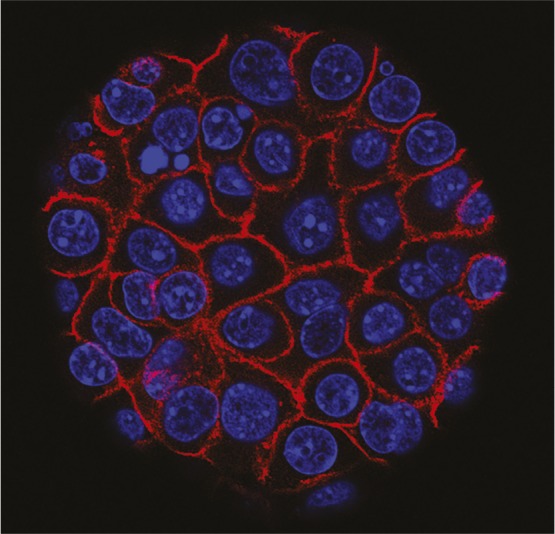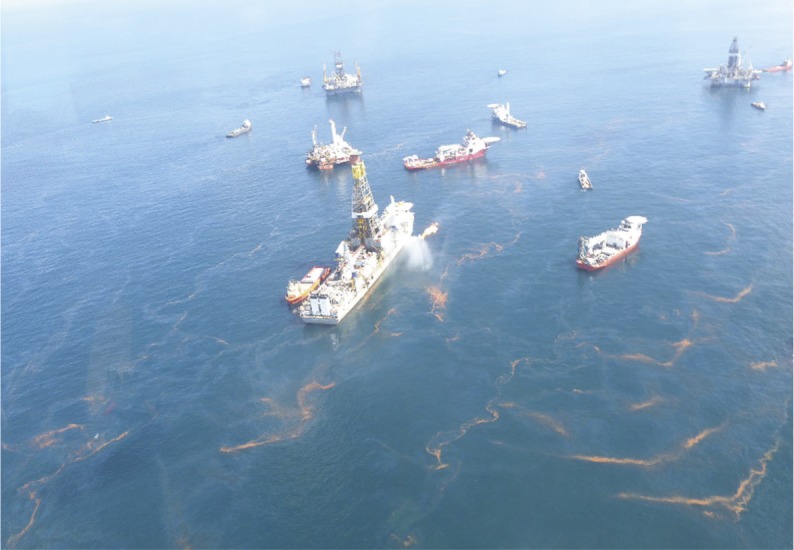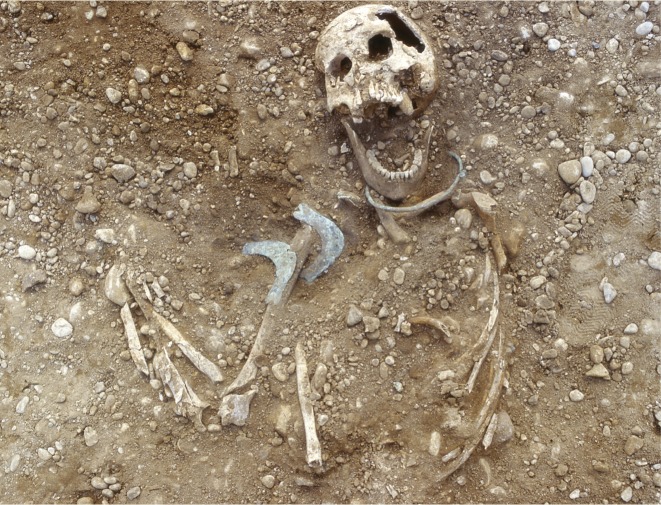Human mobility in early Europe
Burial of a nonlocal female in the Lech River valley area of southern Germany. Image courtesy of Stadtarchäologie Augsburg, Augsburg, Germany.
Human mobility, which includes large-scale population replacements, during the Neolithic–Bronze Age transition in central Europe likely helped spread technological advancements and cultural practices. Yet, how specific age and gender groups contributed to such processes remains unclear. Corina Knipper et al. (pp. 10083–10088) performed genetic and isotopic analyses of 84 skeletons, dated to around 2500–1650 BC, from seven archaeological sites in the Lech River valley area of Germany to examine human mobility during the Late Neolithic and Early Bronze Age in central Europe. Mitochondrial genome data revealed maternal lineage diversification over time, and isotope ratios indicated that the majority of females were nonlocal, having arrived at the sites as adults. Of the nonlocals, only a small subset was identified as males or subadults. The mobility patterns persisted for at least 800 years at the sites. Moreover, the authors identified maternal kinship between a Late Neolithic male and Early Bronze Age female. According to the authors, the results provide evidence of continuing traditions during the Neolithic–Bronze Age transition in central Europe, and suggest that the movement of female individuals was a key contributor to cultural communication and exchange during the Neolithic–Bronze Age transition in Europe. — C.S.
Lead contamination illuminates urban development in ancient Rome
Urban contaminants preserved in sedimentary deposits can offer a historical narrative of economic and industrial development. Hugo Delile et al. (pp. 10059–10064) describe how urban development in ancient Rome can be deduced from lead-contaminated sediments from the city’s first harbor, Ostia. Using high-resolution geochemical and isotopic analyses and radiocarbon dating of a sediment core from Ostia harbor, the authors found that lead pipes used in the aquatic infrastructure of Rome and Ostia were likely the source of lead contamination in the sediment sample. Based on the analyses, the authors stratified the core into three main sedimentary units—preharbor, harbor, and postharbor—that described urban development of Rome’s water system, ranging from the system’s initial expansion to its peak during the early high Imperial period, around first century AD. The authors dated the installation of ancient Rome’s lead pipe system to around second century BC, approximately a century and a half after the introduction of Rome’s aqueduct system. Together with the sample from Ostia, a sedimentary core analyzed from Portus, a nearby entry port constructed during first and second centuries AD, indicated a reduction in lead levels during the Imperial period that corresponded to the contraction of Rome’s water system. According to the authors, the findings might help fill gaps in the history of ancient Rome’s hydraulic infrastructure. — C.S.
European electricity consumption under climate change

Power plant. Image courtesy of Pixabay/SD-Pictures.
Rising temperatures due to anthropogenic climate change have been linked to the supply and demand of electricity in Europe. To examine the future of Europe’s electricity consumption patterns under anthropogenic climate change, Leonie Wenz et al. (pp. E7910–E7918) analyzed high-frequency temperature and electricity use data from 35 European countries between 2006 and 2012, and projected the countries’ electricity consumption for the period from 2013 to 2099. The authors found that, at the country level, daily peak electricity use was generally low when daily maximum temperatures were approximately 22 °C, and increased if daily maximum temperatures either rose or fell. To make electricity use projections, the authors assumed that rising temperatures will lead Europeans living in currently cool climates to adapt to higher temperatures through practices such as installing air conditioners. Based on current electricity use patterns from European countries with warm climates, the authors predict that average daily peak usage and electricity consumption are likely to decrease in northern Europe and increase in southern and western Europe under future warming. Furthermore, the authors found that consumption in many European countries is likely to peak in summer instead of winter by the end of the century. According to the authors, the projected seasonal and geographic shifts in consumption patterns are likely to affect transmission infrastructure, peak generating capacity, and storage requirements. — L.C.
Noninvasive early diagnosis of pancreatic cancer

Pancreatic cancer cells. Image courtesy of Flickr/Min Yu (University of Southern California, Los Angeles) and NIH.
Patients with pancreatic ductal adenocarcinoma face a grim prognosis, with fewer than 9% of patients surviving more than 5 years after diagnosis. Studies have shown that surgically removing tumors when they are small and localized improves prognosis. Joshua Cohen et al. (pp. 10202–10207) combined four cancer protein biomarkers—carbohydrate antigen 19-9, carcinoembryonic antigen, hepatocyte growth factor, and osteopontin—with liquid biopsies of tumor-derived DNA circulating in blood plasma to improve the sensitivity and specificity of diagnosis. The authors applied the combinatorial approach to 221 pancreatic cancer patients with surgically removable tumors and 182 age-matched healthy individuals, and detected tumor-associated mutations in the KRAS gene in the plasma of 66 patients. The mutations matched those found in patients’ primary tumors and were not detected in all but one control, reflecting high specificity. Combining KRAS mutations with protein biomarkers at specific thresholds resulted in a diagnostic sensitivity of 64%, compared with sensitivities of 6–49% when each biomarker was used separately. The findings lay the groundwork for prospective studies that combine circulating tumor DNA with protein biomarkers for early diagnosis of pancreatic and other cancers, according to the authors. — P.N.
Petroleum and dispersant dynamics during Deepwater Horizon

Oil at sea surface above Deepwater Horizon released volatile compounds into the atmosphere. Image courtesy of National Oceanic and Atmospheric Administration.
The Deepwater Horizon blowout in April–July 2010 released 600,000–900,000 metric tons of petroleum liquid and natural gas into the Gulf of Mexico, approximately one quarter of which did not reach the sea surface. However, the effect of injecting chemical dispersants at the wellhead to mitigate the environmental impact of the disaster has remained unclear. Jonas Gros et al. (pp. 10065–10070) developed a physical model of the jet of petroleum liquid droplets and gas bubbles gushing from the wellhead during the period from June 4 to July 15, after the riser pipe was cut, taking into account liquid–gas transitions and dissolution rates of petroleum compounds. Model simulations, which were validated with field observations, indicated that injecting chemical dispersant at the wellhead increased the entrapment of many volatile organic compounds in the deep sea, thereby reducing the release of these compounds into the atmosphere at the sea surface. For example, subsea dispersant injection reduced atmospheric emissions of benzene, a carcinogenic compound, by 2,000-fold for a representative day, according to the model. Subsea dispersant injection therefore decreased health risks to response workers, likely accelerating the response effort, according to the authors. — B.D.



